Strategic Learning Programs
Strategic Learning programs are available through a professional engagement with strategic services. If you would like help with any facet of your email marketing program, contact your account manager or support for more information.
This page provides an overview of the Mapp Strategic Learning programs available for email marketers.
Abandoned Cart
Abandoned cart strategies have changed over time. In the past, marketers avoided the "big brother" mentality by sending emails 1–3 days after the cart was abandoned. Today, messages are sent instantly and incorporate a more relational tone. This approach minimizes the "big brother" feeling and resonates better with consumers and leads to higher conversions.
Between 15% - 50% of carts can be recovered when the user is contacted within minutes of the abandonment with a relational strategy. The content approach - answer further product questions, provide site assistance, offer discounts, and so on - is an integral consideration when putting together an abandoned cart program.

Target Audience for the Abandoned Cart Program
Engagement
Research shows that for email, many marketers resort to a simple and easy approach - batch and blast. However, email actually performs better and provides the best ROI when you successfully connect and engage with the consumer by sending the right email at the right time.
Engagement Programs commonly look to create programs that strengthen the relationship with consumers. This approach does not always include messaging that is intended to sell them something. Often, this program involves creating content like additional product information, surveys, or information on charitable activities. Content that helps to build a relationship.
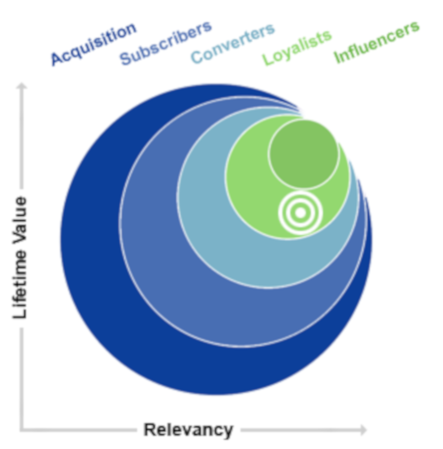
Target Market for the Engagement Program
Lead Nurture
Lead nurture campaigns, also called drip campaigns, automate the communication with customers to keep the sender "top of mind" in the mind of the customer. In a B2B application, companies use lead nurture programs to communicate with sales leads when the sales cycle is longer than a typical B2C sale. This longer cycle can sometimes be up to 30, 60, or 90+ days. Lead nurture campaigns offer an effective way of communicating with customers over a longer period. Rather than a heavy "buy" message, lead nurture programs generally take an informational approach.
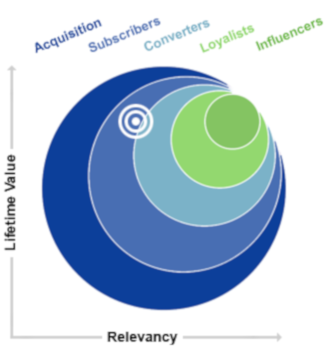
Target Audience for the Lead Nurture Program
Lifecycle Development
Programs that meet the needs of the consumer and based on their position in the marketing lifecycle are key to an effective email channel. During the lifecycle development process, it is important to implement programs that are based on existing engagement and customer need. From a newly acquired subscriber, to a loyalist or an influencer; each stage must have programs that speak specifically to each consumer.
A phased approach is often beneficial. This approach weighs the impact of each initiative against one another to determine priority, and develops programs that contribute to lifetime value and relevancy over time.
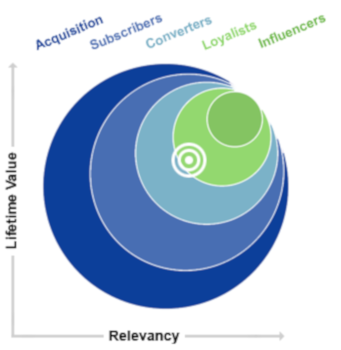
Target Audience for the Lifecycle Development Program
Opt-Down
Studies have shown that the top two reasons for a subscriber to opt out are too many emails and irrelevant emails. Historically, opt out mechanisms have served simply to remove someone from a list completely. Recently, strategy has shifted toward a concept called "Opt-Down".
Opt-Down gives the consumer choices about the emails they get. For example, they can change the cadence of emails they receive (1 per week, 3 per month). They can also change their topic preferences (more information about X and Y, and nothing about Z). Given a choice, marketers would rather communicate more relevant information to a subscriber than lose them completely.
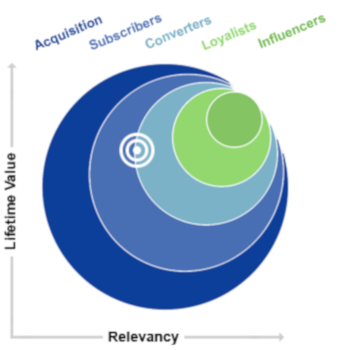
Target Audience for the Opt-Down Program
Segmentation
Relevant email content is integral to higher retention and conversion of customers. To increase relevancy, marketers must use available data to segment subscribers and deliver the right message at the right time with the right content. This segmentation moves beyond just email response data and incorporates any information that the marketer has on the consumer. This data can include information such as geographical data, personas, product preferences, and more. From this data, marketers can formulate behavior trends and develop content that is useful to specific consumers.
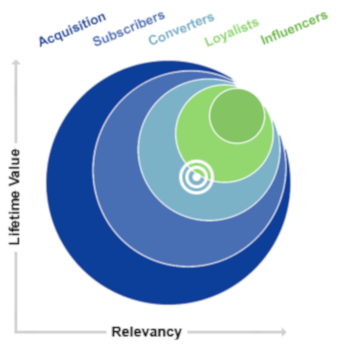
Target Audience for the Segmentation Program
Social Email
Social media allows companies to interact with customers who fall into the Loyalist and Influencer sections on the lifecycle graph. Loyalists and Influencers are different types of people. For example, I typically purchase a certain brand of shampoo. I am loyal to that shampoo, but would probably not speak about it on my social networks. However, I am a huge fan of United Airlines. I talk about their exceptional service and member benefits on my social networks. This outward communication of my inward satisfaction of the company makes me an Influencer.
Therefore, companies have to speak to Loyalists and Influencers in different ways, with a different "voice" and segmentation strategy.
The Social Email program combines preference and activity data from both channels to provide a more comprehensive view of your customers. This data can be used to target like never before.

Target Audience for the Social Email Program
Text to Email
More than ever, consumers are on the move and active in their lifestyle. Therefore, email acquisition is also shifting from traditional methods like POS capture, writing their information on a card, and website capture, to more mobile acquisition tactics.
With the increase in text messaging, marketers have the opportunity to collect information from consumers in an instant way. By texting their email address to a short code provided by a mobile partner, marketers are able to collect accurate contact information instantly. In return, marketers can send follow-up messages instantly. This means of data collection has various uses. Data can be collected at events,with signage, in commercials, and other mediums where the consumer is on the move and more apt to subscribe via mobile than through other means.
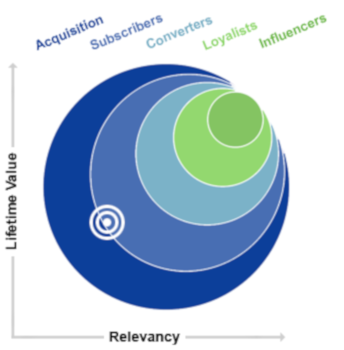
Target Audience for the Text to Email Program
Transactional
Transactional messages represent (on average) about 4% of the email volume in a company. However, these messages can have 60% open rates, and can produce 30% of the total revenue for an email program. With these astounding numbers, it is surprising that many companies do not take advantage of this prime revenue source.
It is important to understand the components that can be included in transactional emails: CAN-SPAM requirements, the integration of third-party dynamic content, HTML vs. text, send times, and so on.
Mapp can help you navigate the requirements and recommended the best practices to ensure the success of your transactional program, and ultimately, drive more revenue.
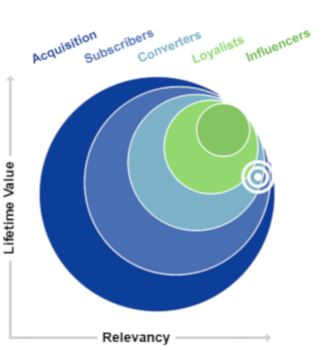
Target Audience for the Transactional Program
Video in Email
Video in email is quickly evolving into a valuable way to communicate with subscribers in an engaging way. However, many marketers are unclear on its potential. Therefore, this method remains a relatively untapped opportunity because of past challenges with available technologies and email client limitations. The "newness" of video in email can work to the advantage of the marketer - due in part to its less prolific presence in email. Video in email provides the potential for increased subscriber interaction, viral growth, and high results.
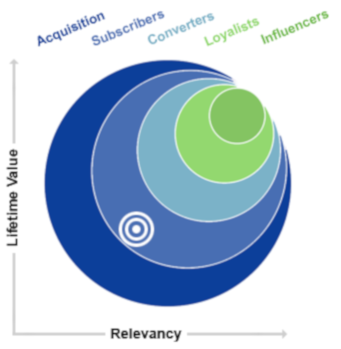
Target Audience for the Video in Email Program